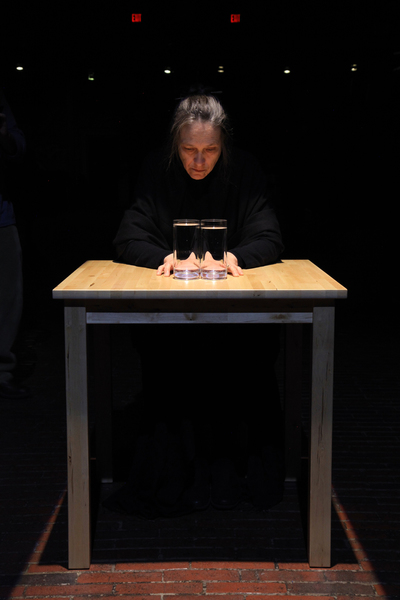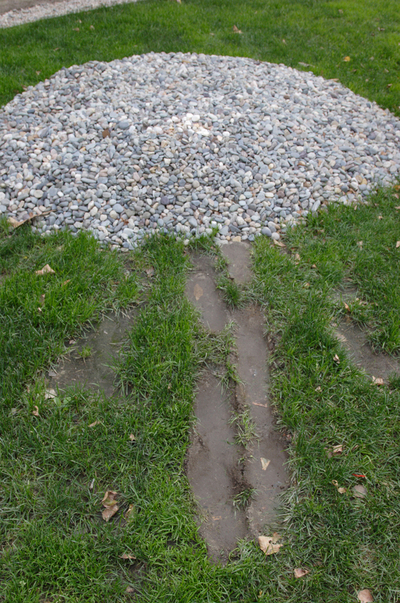It’s About Time: Thoughts on the Rise of Extended Duration in Performance-based Practices By Sandrine Schaefer
Performance Art, a near relative of conceptual art, has been misconstrued and misinterpreted amongst general audiences for decades. Lately, though, artists like Marina Abramovic have become quite well known, rubbing elbows with and inspiring celebrities of all disciplines to try on the identity of “Performance Artist” by practicing the Abramovic Method. Indeed, writer Robin Deacon might have difficulty sifting through current references to performance art in the mainstream if he ever chose to update his 2008 video compilation of television and film mentions to the medium.
As a Boston-based artist working with experiential media, I recognize my privilege. Considered the performance art mecca of the United States, Boston is home to the first performance art department housed within an art college at The School of The Museum of Fine Arts, The Studio for Interrelated Media at Mass Art, and Mobius, an artist group and organization supporting experimental time-based media that has sustained momentum for close to 40 years. In addition, countless experimental artists, curators and initiatives make up Boston’s network of creative minds.

MarilynArsem photobyDanielDeLuca
The work that is being made in Boston has been ahead of the curve, causing me to occasionally roll my eyes at the seemingly sudden popularity of performance art in the mainstream (I was a fan of [insert band of choice] before they got famous) I am not alone. Social media is fiercely documenting the rise of performance art in the mainstream, creating heated dialogues between those who have spent lifetimes studying and working within the medium and those who are seemingly ‘following the trend.’ When I remove my armor disguised as pretension, I realize that this moment in art history is one that must not only be embraced, but also seized. Fortunately, I am not alone in this mindset either.
This past summer, six large-scale international performance art festivals took place throughout the United States. After witnessing several of these festivals, it became clear that the performance art festival is not the most conducive format for works that explore extended durations of time, yet there was an abundance of durational performance being made and an overall interest in work that dissects time as material. In the traditional festival atmosphere, durational work is often set up to be unintentionally disregarded. There is a default that invites audiences to enter and exit durational pieces as they please, compromising the level of intensity of audience engagement. Durational pieces are often placed either in other rooms or around the perimeters of spaces where shorter timed pieces are also occurring, creating a tension for the audience to choose where they give their attention. This can create a sense of competition between pieces, resulting in a confusing and chaotic experience for the viewer.
These choices are frequently results of the practical challenges that come up when programming pieces unfold over long periods of time. This kind of work naturally breaks the traditional performance space by challenging the audience continuously to consider their behavior and confront their ethos around witnessing live art. This can be uncomfortable for the audience, but if a spectator stays with a piece, there is potential to experience the liminality that is often perceived as being reserved for the artist alone.
Many members of the public experienced this when Marina Abramovic’s retrospective at MOMA, The Artist is Present received international attention. Spectators traveled from all over the world and camped out to engage in eye contact with the “God-Mother of performance.” In a time when attention spans are encouraged to become shorter and shorter, the inherent endurance required in creating and witnessing durational work has become subject to sensationalism. The Artist is Present was a spectacle of sorts that offered audiences the opportunity to engage in this feat of endurance. The boundaries between audience and artist were erased because the viewer was invited to invest her/his own time to perform an action alongside the artist. This leveling of the playing field between artist and audience is often inherent in durational work. Extending time expands the opportunity to explore the artist and audience relationship.
For 1 hour each day for 2 years, Joanne Rice offers passersby in Copley Square a moment of contemplation in her piece, The Human Cost of War (2007-2009). Unassumingly standing in front of the Trinity Church, Rice deposited 100 stones, one by one, into a large pile each day, a memorial for lives lost in war. Mobius Founder Marilyn Arsem lays motionless under a bench in the Egyptian Galleries of the Museum of Fine Arts, Boston, for nearly seven hours, her body suspended in stillness and emitting the aroma of jasmine.

JoanneRice photobyBobRaymond

JoanneRice photobyBobRaymond2
Boston is a place of patience, teaching, supporting and appreciating durational performance-based practices. Even action-based artists who work in Boston who do not necessarily consider their work durational would fit into this category in any other place. This city has also seen numerous exhibitions/ events carefully curated to support work that explores extended duration. In 2006, Dirk Adams curated Elapse, a 24-hour performance event. While artists created pieces that traveled through the hours of the day, several spectators brought sleeping bags to the event to ensure they didn’t miss anything. In recent years, Boston’s commitment to supporting durational works reach their fullest potential has become apparent in innovative programming of time-based work. Alice Vogler and Vela Phelan’s Time Body Space Objects is a 12-hour performance art event that openly challenges the festival format. Twelve artists are invited to participate and choose an hour out of a hat. The artists use their hour to create a piece that responds to the theme, “commitment” and must incorporate their setup and clean up during that hour. Although one hour isn’t a particularly long duration of time, witnessing one piece at a time provides a focus for both the artist and spectators that is well suited to exploring time as material. Offering audiences the choice to endure 12 hours of performance art, gives spectators the chance to explore their own relationship to time in a communal environment. Mobius’s recent programming has also utilized a structure of showing one performance per evening, allowing individual works to be developed over several hours and experienced with breathing room.
These explorations in programming are not limited to Boston. In recent years, Brooklyn has experienced resurgence in performance-based work. Grace Exhibition Space, a steadfast presence in the international performance art community, began a durational program this year. This year also welcomed Glasshouse into its Brooklyn location. This “art-life-lab” founded by artists Lital Dotan and Eyal Perry works under the motto “art should be experienced in a place that allows staying.” Supporting the development of performance-based work that explores extended durations and erases the boundaries between every day and art action, Glasshouse provides opportunities for artists and audiences to experience art and discourse in the domestic sphere. Using their own home as Glasshouse’s exhibition space, Dotan and Perry are also blurring the boundaries between artist/audience/curator. Home is a space that carries an expectation to spend time engaging in a multitude of actions, ranging from mundane to symbolic/ solitary and communal. To make and experience the accumulation of these kinds of actions within the context of a home illuminates the various states of flux that occur naturally within durational performance.
In a cultural climate where perceptions of “real time” are rapidly shifting, it is no wonder why performance art, specifically the genre of durational performance, has gained popularity throughout the U.S. As general audiences navigate “reality” television, “real time” technologies and the instant gratification provided by social media, the masses are reimagining their perceptions of time and exploring how to manipulate it. Performance artists have been using time as material for decades. Now that the medium is gaining awareness in the mainstream, it is refreshing to witness artists and curators asking audiences to bring intention to their relationships to time. As we use this point in history to re-evaluate how creative thinkers and makers have utilized time in the past, we are contemplating the relevance and potentials of time as material in the 21st century. These dialogues invite the development of uncharted strategies that support the evolution of experiential art mediums. They simultaneously inspire a shift in collective consciousness in how we might further understand time on a primordial level.
Sandrine Schaefer is a Boston-based artist, educator, and independent curator. Sandrine has exhibited her work extensively, nationally and internationally. She is a co-founder and director of The Present Tense, an art initiative that produces, documents and archives live art events, festivals, exhibitions, and exchanges. Through her curatorial endeavors, Sandrine has shown the work of more than 300 artists from around the globe. Her writing on contemporary experiential art practices has been published in numerous international online and print publications. She currently teaches performance art practices at Montserrat College of Art and through the SIM Department at Massachusetts College of Art.
